Everyone knows the pattern. A PM writes a doc, a designer turns it into screens, and then engineers rebuild it in code. By the time it reaches customers, the idea has melted. That cycle of handoffs is why large teams move slowly.
A Visual IDE breaks that cycle.
An IDE, such as VS Code or Cursor, gives developers a powerful environment to write and manage production code. A Visual IDE has the same foundation, but it is accessible through the browser and usable by product managers and designers as well. You can create a branch, edit visually, generate code with AI, and open a pull request without setting up a local environment.
This is not the same as an AI app builder. App builders are built for quick MVPs, usually on a locked stack with disposable code. A Visual IDE integrates into the systems your teams already use: GitHub, your design system, your repos.
App builders are like site builders like Wix or Squarespace, consumer-grade tools for quickly standing up a site. A Visual IDE is closer to VS Code, but built so PMs and designers can use it too.
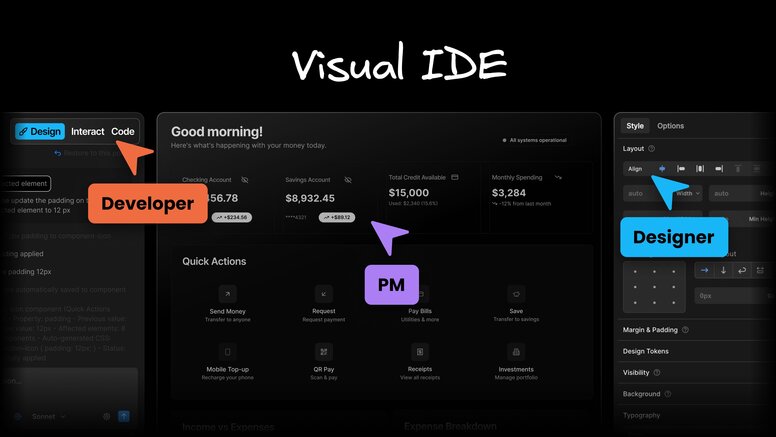
The traditional product workflow is slow and brittle:
PRD → wireframes → designs → rebuild in code.
Every step loses fidelity. It is like passing a melting ice cube. By the time something reaches a customer, it has already drifted from the original idea. Feedback arrives late, rework piles up, and the cost of change rises with every cycle.
So you have your committee debate the words. Scope creep happens like crazy, usually, and these are not people with design eyes. When you want a great end result, like an Apple product or an Airbnb product, you want a simple final result. Airbnb, famously in planning, would do storyboards like Disney and pick at them. Most companies don't. They lock everything in text, and text is not going to take into account what makes for a simple user experience.
Design leaders we spoke to told us their designs often sit in backlog for four to six weeks before development even starts. Product managers we interviewed reported wasting weeks or months on features that later get scrapped after user testing. These are not edge cases. They are symptoms of a workflow built on handoffs.
A lot of good ideas and premium code die and never finish. Too many designs have been designed and there's no developer building them. Too many PRDs get written and end as text. If you go straight from idea to code, designs that are designed are already built by deafult. They can go live, even if the intention is "prototype."
For a startup, the damage is survivable. For an enterprise, the damage is compounding. Entire quarters get lost in translation.
A Visual IDE compresses that workflow. Product managers can prototype directly in real code, without begging for engineering time. Designers refine those same branches, adjusting responsiveness, accessibility, and interactivity in ways static tools like Figma were never meant to handle. Developers inherit work that is already validated with stakeholders and even customers. The best prototype is a draft implementation in product, in context.
The effect is that teams shift from working in sequence to working in parallel. Feedback loops tighten. Fidelity loss disappears. Everyone stays closer to the customer problem instead of chasing artifacts through documents and slides.
The result is iteration that is both faster and higher in quality.
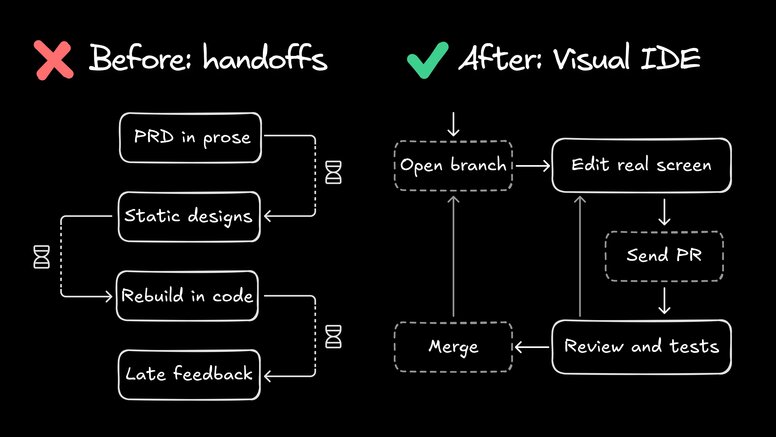
Product managers. The wait disappears. Open a branch in the browser, make a real change to a real screen, wire sample data if needed. By lunch you can put it in front of a user. By end of day engineering reviews a pull request instead of a document. The practical win is faster validation and cleaner scoping. When you can see the idea in code, the tradeoffs are obvious and you cut the right corners on purpose.
Designers. The source of truth is code, not a screenshot. Shape responsive layouts, focus states, motion, and accessibility where they actually live. No more redlines that go nowhere. No more "close enough" rebuilds. If something needs polish, push the change, ask the IDE to clean up the small stuff, and keep moving. The design system is enforced by the code, so your effort compounds instead of drifting.
Developers. Your time shifts to the hard parts. Instead of transcribing a Figma file into CSS, review a branch, request small fixes, and focus on architecture, data flow, and performance. If a generated diff is messy, ask the IDE to normalize it, or do it yourself and let the model learn from the edits. You still have code owners, tests, CI, feature flags, and release gates. Nothing merges unless the bar is met. The handoffs are gone. The guardrails remain.
How a day looks in this world: a PM drafts a change at 10 a.m., design tightens behavior and responsiveness on the same branch, and by 3 p.m. we have user notes. Engineering reviews before close, fixes two nits, and marks one item for follow up. That is the difference between debating a PRD and trying it on.
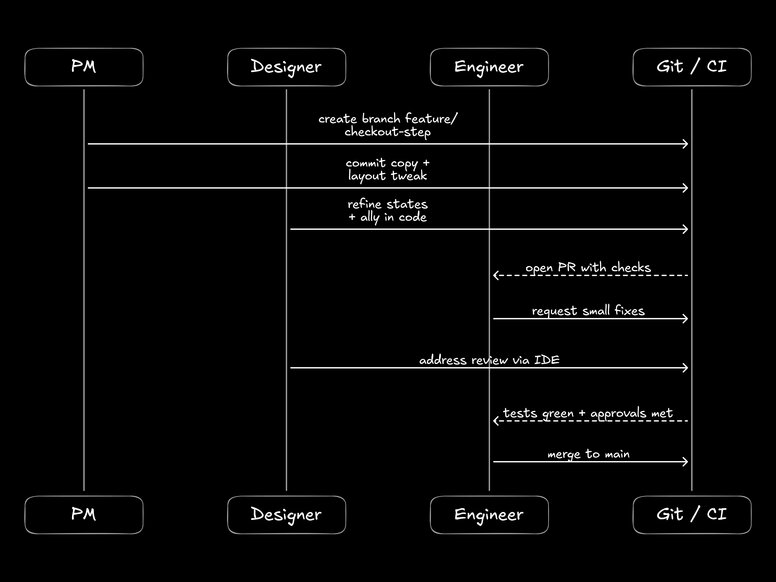
At the organizational level, the payoff is velocity. Enterprises regain the ability to iterate like startups, but without losing the governance and scale they need to protect.
AI app builders are fine for quick experiments with a hosted, prescriptive stack. Most teams do not live in greenfield. A Visual IDE starts in your codebase, uses your components and design system, and produces code that can ship.
If you want the detailed side by side, read Visual IDE vs AI App Builder.
The first misconception is that a Visual IDE is just another app builder. It is not. App builders produce disposable apps. A Visual IDE produces valid, compliant, production ready code.
The second misconception is that it replaces engineers. It does not. Engineers still own architecture, scale, and backend systems. What changes is that PMs and designers can contribute in code earlier. Engineers inherit work that is already validated, reducing rework and debate.
The third misconception is that AI alone is enough. Tools like GitHub Copilot can autocomplete code and speed up typing, but they do not change the workflow itself. A Visual IDE does. It skips entire steps.
Sometimes the AI is wrong. That is expected. Keep it inside normal guardrails. Changes land as a branch and a pull request. The design system and component mapping constrain what gets generated. CI, tests, and code owners decide what merges. If the output is off, ask the IDE to fix it, or edit the code yourself. A bad generation becomes one more code review, not a week of rework.
A Visual IDE is not for everything. Heavy backend systems, extremely complex features, and deep infrastructure work still need traditional engineering workflows.
If your compliance model forbids connecting repos to any cloud, run locally. If your design system is thin or inconsistent, invest there first or you will not get the full benefit. This removes handoffs. It does not replace craft.
For front end flows, prototyping, and iterative product work, the effect is transformative.
AI for developers has mostly been about incremental speedups. Copilot makes you type faster. Agents can draft boilerplate. These are useful, but they are not transformative.
A 2023 controlled study found that developers using GitHub Copilot completed a benchmark HTTP server task 55.8% faster than those who did not. Another field study across 4,800 developers showed that Copilot users produced 26% more pull requests per week than peers.
These are real gains, but they are incremental. A Visual IDE is different. It removes steps entirely. No PRD to mockup to rebuild. No waiting weeks for engineering bandwidth. It is a workflow shift, not a speed bump.
The urgency is real. In Figma's 2025 AI report, 34% of teams said they shipped AI-powered products this year, up from 22% in 2024, and 56% integrated AI into existing products. Smaller companies are adopting faster than enterprises, raising pressure on larger organizations to keep pace.
Startups adopt new tools quickly because they can. Enterprises adopt carefully because they must. Governance, compliance, and scale are non-negotiable.
Enterprises don't want three sources of truth. They don't want design in Figma, the code in code, and some net-new prototype tool, all with different design-system details. They want components in one place, always up to date. They want creations to go to code, because code is what matters most.
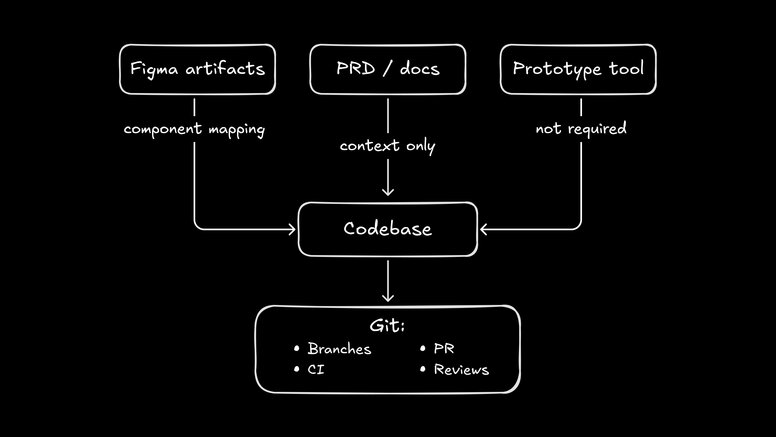
A Visual IDE is built with those concerns in mind. It works with any tech stack instead of prescribing one. It integrates with existing design systems and component libraries. The code it produces is reviewable, testable, and compliant. And it scales to massive codebases, monorepos of the kind used at companies like Google.
The pressure is rising. In one survey, over half of development leaders (52%) reported that their organization has increased the amount of software shipped over the past two years. The only way to sustain that growth is to cut out wasted cycles.
The bigger story is not the tool itself but what it enables: everyone working in code.
This is not about creating a new role called "builder." It is about empowering the roles that already exist, PMs, designers, engineers, to work directly in the shared language of product development.
The simplest "aha" moment is twofold. One is taking an idea directly to a live, functional UI in an existing codebase using your design system and tech nearly instantly. The second is sending that first pull request from a non-developer and seeing it merged. Seeing the idea from your head reach production users is hard to forget.
Visual IDEs are how teams escape the handoff economy. They put prototypes, validation, and iteration directly in the hands of PMs and designers, while keeping developers in the loop on real code.
The result is iteration that feels like a startup, but at enterprise scale.
If you prefer proof over promises, open a branch in Fusion, edit one real screen, and send a pull request. It takes less time than writing a ticket, and it tells you more than a slideshow ever will.
If you want to see it in action, try Fusion. Fusion is the Visual IDE we built for teams that need startup speed without losing governance or scale.
Builder.io visually edits code, uses your design system, and sends pull requests.
Builder.io visually edits code, uses your design system, and sends pull requests.



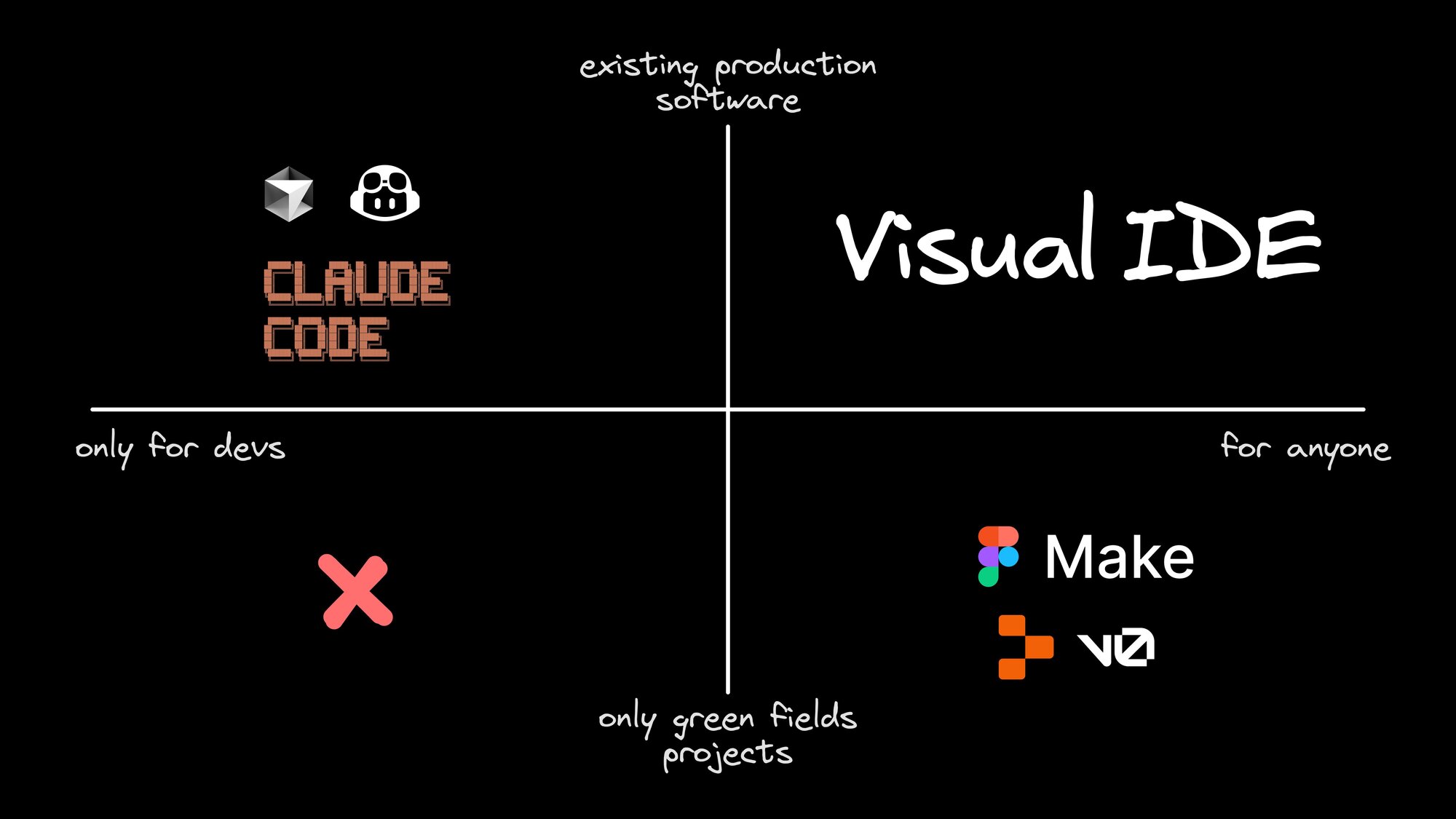
 Connect a Repo
Connect a Repo











